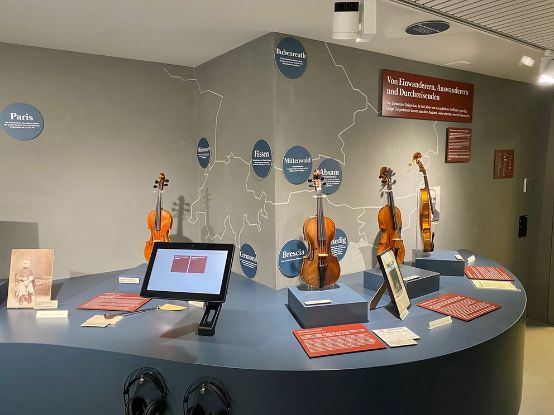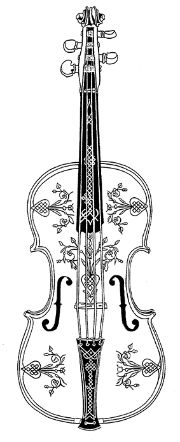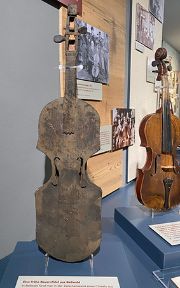Fiddles and master violins
A new permanent exhibition at the violin making school in Brienz documents the history of this instrument in Switzerland.

A new permanent exhibition at the violin making school in Brienz documents the history of this instrument in Switzerland.
When the Swiss violin making school in Brienz was extended, two showrooms were planned. One room shows the recently opened permanent exhibition on violin making and violin playing in Switzerland, the other the development of a violin, in-house stringed instruments as proof of performance and documents the eventful history of the violin making school founded in 1944.
Admittedly: The new violin museum is small, with around twenty exhibits. Hikers walking from Brienz railroad station along the lake towards the church who want to get an idea of the Swiss violin can gain an overview in ten minutes. However, those who take the time to read the text panels and all the information available via monitors in the form of images, spoken word and musical examples will be rewarded with an originally presented, multifaceted history of the Swiss violin.
The violin in art and folk music
The theme "Of fiddles and master violins" can already be illustrated in Switzerland with exhibits from the late 17th century. In Oberbalm near Bern between 1685 and 1699, the carpenter Hans Krouchdaler made stringed instruments decorated with geometric and plant ornaments in the style of the Alemannic school from the Black Forest. He is considered to be one of the oldest violin makers north of the Alps. The tenor violin from 1699, a magnificent testimony to old craftsmanship, was probably played in a municipal Collegium musicum. This artistic instrument, carefully restored by Hans-Rudolf Hösli, the former director of the violin-making school, is juxtaposed with a sooty peasant fiddle from Bellwald (Goms) made by the player himself or by a local carpenter. It also dates back to the 17th century and is reminiscent of "runaway" musicians who often played for dancing, which was often forbidden.
Domestic and foreign violin makers
The tension between folk and art music can also be observed in 19th century violin making. Aloys Suter (1809-1892) from Muotathal made violins for folk musicians, was involved in the development of the Glarus zither and emigrated to America in 1879 in the hope of a better life. In Newark near New York, he founded a store for musical instruments, which flourished until the early 20th century.
This daring autodidact from the canton of Schwyz was contrasted by foreign violin makers who settled in Swiss cities. The experimental Eastern Frenchman François Marie Pupunat (1802-1868) opened a workshop in Lausanne, Giuseppe Fiorini (1861-1934) from Bologna made his fortune in Zurich and August Meinel (1868-1961) came to Basel from Markneukirchen. In 1915, the Italian succeeded in acquiring drawings, inner molds and all the tools from the estate of Antonio Stradivari, who had died in 1648, and in this way introduced Cremonese violin making to Switzerland. The violin maker from the Vogtland region, however, brought the experience of the string instrument makers from the musical corner to Switzerland and also supported the amateur and wind orchestras in Basel as a horn player and conductor. Among the Swiss who learned violin making abroad was Gustav Methfessel (1839-1910) from Bern, son of the cellist and composer Adolph Methfessel, who completed his apprenticeship in Regensburg. He established himself as the first Bernese violin maker in his home town in 1864.
Swiss compositions for string instruments
The rich sound bar presents an astonishing selection of Swiss compositions for string instruments from the 18th to the 20th century and reveals the musical knowledge of the current director of the violin making school, Olivier Krieger, a long-time orchestral musician and violin maker. Swiss violin music of all kinds is available in 20 audio samples: folksy solo dances from Graubünden, old and new Appenzell string music, a sonata movement by Gaspard Fritz from Geneva, string quartets by Joachim Raff, Hermann Suter, Fritz Brun, Fritz Voegelin and Roland Moser, solo pieces by Walter Courvoisier, movements from violin concertos by Othmar Schoeck, Willy Burkhard, Caspar Diethelm and Robert Oboussier, string ensembles by Frank Martin and Heinz Holliger and cello music by Arthur Honegger and Hans Huber.
The violin school in Safiental
In addition to internationally acclaimed violin soloists, who have been enchanting Swiss concert audiences in urban centers and at Alpine music festivals for over a hundred years, the silent cultivation of the violin in the Grisons Safiental (Surselva) is also presented. As early as the 19th century, the boys of the individual farmsteads were taught violin making and playing by far-sighted teachers. One of the surviving dance manuscripts is on display in Brienz.
The new exhibition at the Swiss violin making school provides a lot of inspiration. Perhaps it will also help to raise the cultural treasure from the Safiental.
Swiss violin making school Brienz
Exhibition "Of fiddles and master violins"
Opening hours: Wed and Fri 2pm - 4pm; Sat 11am - 3pm
Free admission










